Al-Qaeda and the Islamic State: Gaging Failure and Success in Online Jihad
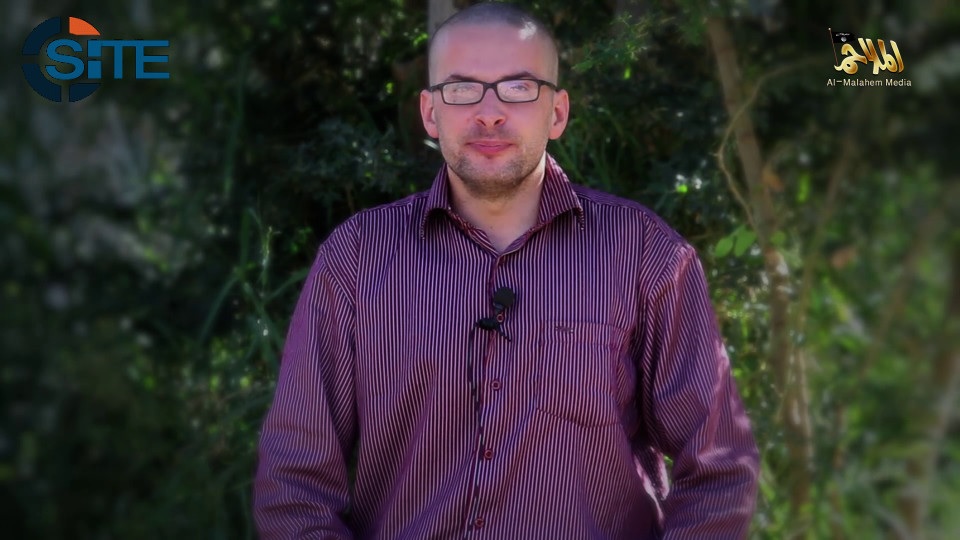
We always hear about the overwhelming social media campaigns by the Islamic State (IS), and how they flood the internet with gruesome images of beheadings, threats, military achievements, and victories. But what about al-Qaeda (AQ) fighters and supporters? After all, geographically speaking, they include a much larger array of areas and groups, from AQ in Afghanistan, Shabaab al-Mujahideen in Somalia, al-Qaeda in the Arabian Peninsula (AQAP), al-Qaeda in the Islamic Maghreb (AQIM) in Algeria, and al-Qaeda in the Indian Subcontinent (AQIS).
With these questions in mind, a comparison of a recent social media campaign by AQ/AQAP supporters following the failed U.S. rescue mission (and consequential execution) of Luke Somers, to those more successful ones launched by IS supporters, provides a better scope of success (or lack thereof) in today’s jihadist social media campaigns.
Immediately after news of the failed U.S. rescue mission for Somers, pro-AQ jihadists capitalized on the event by initiating a celebratory, anti-U.S. campaign on social media. America’s failed mission, viewed as a great 'victory' by AQ against the American's most elite units, was a unique opportunity for AQ fighters and supporters to tout their strength and mobilize their followers on social media with the same success Islamic State (IS) supporters have achieved many times in the past.
Once the news about the failed rescue mission broke, a pro-AQ user under the name “Desired for Paradise” initiated the campaign with an Arabic-language tweet, asking members:
We hope for the activation of this hashtag for putting pressure on the US administration ..
The tweets should be in English tweets
#Obama_kills_Luke_Somers

Mere seconds after its creation, users tweeted the hashtag along with anti-American statements and threats. For example, one minute after the post of the hashtag, user “Gharib al-Shamri,” an Arabic speaker and AQ supporter, also began mobilizing Twitter members to use the hashtag against the US government, tweeting:

Following these initial tweets, other users also began pushing for further momentum of the hashtag by attempting to hijack trending hashtags. A minute later, the same user tweeted the hashtag again, this time with hashtags of news stories relevant to Americans, including the Ferguson protests:
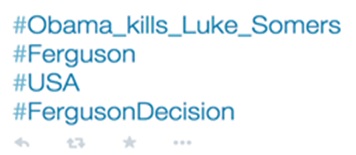
A prominent pro-AQ jihadist Twitter page, belonging to an Arabic speaker, under the username “The Retired Politician,” joined the campaign with vigor, urging his 75,000+ followers to take part in series of tweets. His first tweet advertising the hashtag, using the original text tweeted by “Desired for Paradise,” was posted two minutes after the creation of the hashtag and was retweeted 25 times.

To obtain further exposure, Retired Politician followed up with another tweet, adding trending hashtags:
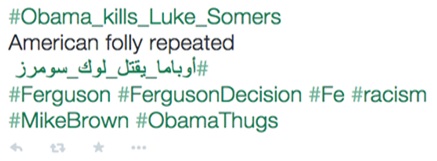
At this point, successful social media campaigns would have taken off, with the pushed hashtags and their respective messages being shot into all corners of Twitter by prepared and eager users. This campaign launch by AQ supporters, however, would begin to fall apart before ever leaving the ground.
Perhaps one of the most prevalent of their problems was the Arabic-English language barrier. Another tweet by Retired Politician using the hashtag read in English, “How long tolerate the lives of Americans.” Despite being retweeted 20 times, another user responded to Retired Politician’s tweet, stating, “Your words don't make sense, don't use google translations.”
Further confusing—and thus damaging—the campaign was the account of al-Nour Media, a pro-AQ media group based in Aleppo Syria. To a tweet by Retired Politician, al-Nour Media, confused about the spelling of "Somers," replied “correction: should be sumers.”
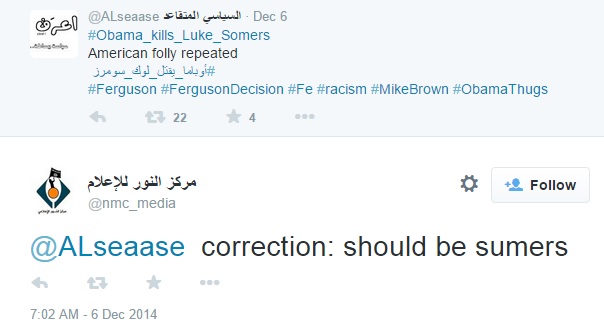
Both before and after this flawed correction, al-Nour Media made tweets using the hashtag, “#obama_kills_luke_sumers”:

However, though al-Nour Media’s account tried to mobilize members to use the hashtag, no one actually did. From there, the account began using the correctly spelled hashtag, even with the same tweets it had previously made:

Perhaps frustrated of the lack of the hashtag publicity, tweets from users like Retired Politician started to include anything that could publicize it. In a previously mentioned tweet, the user even resorted to irrelevant hashtags like “#Christmas” and “#Iphone”—choices showing both a brazen selection of random trending hashtags (not to mention complete ignorance to how bizarre such a tweet would look to English language users).
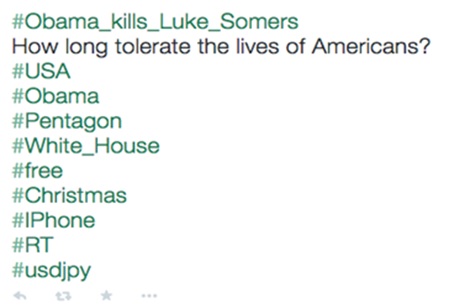
To very little surprise, it didn't help.
Two days after the campaign’s initiation, “#Obama_Kills_Luke_Somers” remained to be the primary hashtag used by AQ followers. The hashtag, however, accumulated under 300 tweets—a staggeringly low result compared to those of other jihadist campaigns on social media. An Arabic version of the hashtag did even worse, raking in roughly a dozen tweets.
It is further damaging to compare this failed campaign to any of IS’s previous campaigns, which, even for the most mundane of events and issues, lead to tens of thousands of tweets. Compare the “#Obama_Kills_Luke_Somers” hashtag to “#StevensHeadinObamasHands,” used by IS-supporting users to form a massive conversation regarding what was the pending execution of Steven Sotloff by IS. The tweet would reach 118,000 uses in under a week—facilitating messages from both IS supporters and angry Americans roped into rebutting them.
Other quickly ignited campaigns by IS have made similar strides. Following President Obama’s announcement of airstrikes in Iraq this past summer, jihadists responded by using a previously used hashtag, “#CalamityWillBefallUS,” and instantly taking it from 0-33 daily uses the previous month, to 863 uses on August 7.
Another campaign, powered by the hashtag, “#IraqiLies,” was used by IS fighters and supporters to dispute reports of IS brutality in Iraq. In just one day, the hashtag exceeded 800 uses.
IS’s campaigns boast not only numbers, but also visual elements as well. Amid the “#CalamityWillBefallUS” campaign, as is always the case, IS-aligned jihadists created threatening and offensive artwork showing the 9/11 attacks, dead soldiers, and threats toward the White House and U.S. companies.

So why did the AQAP campaign fail?
Juxtaposing AQ supporters’ failure to IS’s successes shows two important things. First, it highlights the benefits of IS’s swath of Western followers, many of whom being young, tech-savvy individuals. These users, by their lingual and technological advantages, have proven to be far more effective in bringing jihadist statements to the eyes and ears of Westerners. Furthermore, IS social media accounts show a well-organized structure of media organizations, accounts designated for publicity generation, and celebrity-like personas taken on by the group’s fighters and recruiters.
...a victory against the U.S. is not a victory by itself; it is in the hype created afterward that the true benefits of such events, such as AQAP’s killing of Somers, are seen by jihadists.
Secondly, this failed campaign shows how important social media has become to the jihadist movement in recent years. Minding the undisputable benefits IS has reaped from its social media barrages, AQ supporters saw America’s failed mission against AQAP as their ticket to reap the same results. Statements by Desired for Paradise and Retired Politician, wherein they bluntly established (or at least attempted to) a hashtag to push through Twitter, show that a victory against the U.S. is not a victory by itself; it is in the hype created afterward that the true benefits of such events, such as AQAP’s killing of Somers, are seen by jihadists.
For AQ supporters, the campaign’s low numbers mark a serious missed opportunity by the group for attention and recruitment momentum. In the case of AQ and AQAP supporters’ campaign, what was hailed as a victory by many supporters of these groups will likely be overshadowed by the victories of IS, a group which has undoubtedly mastered the science of social media campaigns.
Don’t be mistaken; AQAP’s failure at social media campaigning does not come from a lack of popularity. Of all the AQ branches, AQAP is most admired by jihadists—including many within IS. However, respect and successful military operations are not the only sources of support among jihadists. In this new age of terrorism, a social media-savvy jihadist can generate a digital riot on a whim, while the exploits of a war-endured jihadi fade to nothing.
